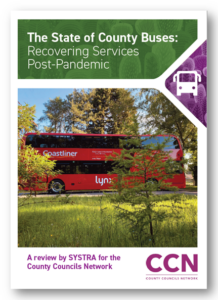
CCN Latest News, CCN News 2023 | 19 July 2023

In light of the growing pressures facing county bus networks, CCN engaged SYSTRA in 2023 to undertake a comprehensive review of the English bus services offer and the impact of recent policy developments.
The study, released today, concludes that many services in rural areas were already in state of ‘managed decline’ but the pandemic has accelerated this – with the government’s much-vaunted National Bus Strategy doing little to address these issues.
 This is because two-thirds of the government’s £1.1bn to address the decline in buses went to urban areas. These areas benefited from hundreds of millions more in investment despite witnessing the smallest declines in passenger numbers in the lead up the pandemic, the report shows.
This is because two-thirds of the government’s £1.1bn to address the decline in buses went to urban areas. These areas benefited from hundreds of millions more in investment despite witnessing the smallest declines in passenger numbers in the lead up the pandemic, the report shows.
Download the report here.
For the first time the report reveals that the 37 largest county and rural authorities – representing almost half of England’s population – submitted Bus Service Improvement Plan (BSIP) bids which collectively totalled £3.6bn, but these councils only received 10% – £363m – of the funding requested, with urban areas receiving £739m.
With the government’s strategy failing to match CCN councils’ ambitions, local authority leaders have said that the government must revisit the funding made available to invest in making buses more punctual, greener and reliable in county areas, as well as making permanent the £2 fare cap to drive up usage.
The report, The State of County Buses: Recovering Services Post-Pandemic reveals:
The government did step in during the pandemic and ensure that more services were not lost by subsidising councils and commercial providers at a time when passengers numbers decreased sharply. It then launched its National Bus Strategy in 2021 which included the requirement for local transport authorities to produce BSIPs in order to access funding.
With the report highlighting that county areas – particularly those who missed out on the first round of BSIP funding – only received a fraction of what they need to deliver their ambitious bus service transformation plans, it recommends that the government launches a further round of BSIP funding and allocates money on par with the level of ambition from councils.
With many councils concerned over the lack of clarity as to why some bids were successful and others were not, the report recommends that any future funding sets out clear criteria on how allocations are decided.
As county and rural areas have seen the sharpest declines over the last decade, the report calls for a ‘County Bus Strategy’ to address the specific issues in those places, as well as a direct revenue stream for buses, and the permanent introduction of £2 fares.
 Cllr Stephen Giles-Medhurst, Transport Spokesperson for the County Councils Network, said:
Cllr Stephen Giles-Medhurst, Transport Spokesperson for the County Councils Network, said:
“Buses have long been a lifeline for many people in rural areas, particularly the elderly and the disadvantaged. But outside of London and the cities, far too many services are at best, patchy, and at worst, non-existent. The pandemic has accelerated the trend of declining usage and journey are now at a historic low.
“We had high hopes for the government’s National Bus Strategy, especially as the support for services during the pandemic was comprehensive. But many county areas were left felt let down with their funding allocations, with the majority of fund being directed to the places that arguably needed the least help.
“As their bids for the funding showed, councils have serious ambitions when it comes to improving and modernising their bus services. But it is increasingly likely that reversing the decline in passengers is a challenge to picked up by a future government, and today’s report sets out a number of recommendations to transform local services. Failure to act will keep buses in county areas in a state of managed decline, with consequences for our residents.”
Notes to editor
| Total BSIP & BSIP+ Allocation[1] | Reduction in Passenger Journeys 2011-19 | Average Passenger Journeys Per Head 2018/19 | ||
| £m | % | % | Per Head | |
| CCN Member Councils that received BSIP R1 | £322.9 | 29% | -11.7 | 29.4 |
| CCN Member Councils that did not receive R1 BSIP | £40.2 | 4% | -15.6 | 20.7 |
| Metropolitan & Other Unitary Councils that received BSIP R1 | £722.7 | 66% | -7.4 | 69.6 |
| Metropolitan & Other Unitary Councils that did not receive BSIP R1 | £16.4 | 2% | -13.2 | 42.3 |
| England Total/Average | £1,102.3 | 100% | -6.8 | 72.3 |
© 2024 County Councils Network | Credits | Site map | Cookies | Privacy Policy.